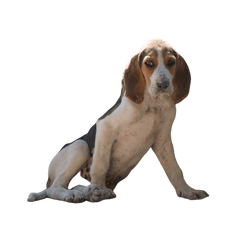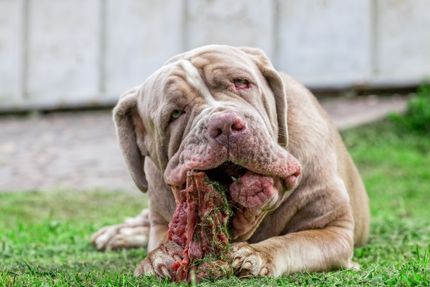
Miniature Schnauzer Breed description: Character & Co
Miniature Schnauzer
Facts & Origin
Origin and history of the Miniature Schnauzer
The origin of this old breed is Germany, in the Frankfurt/Main area. There, in 1880, the first certified official breeding began under the name "rough-haired dwarf pinscher". But the breed is actually much older. Its ancestors probably originate from a crossing of the medieval beaver dogs with shepherd dogs. Similar to the Miniature Schnauzer looking dogs can even be seen in medieval paintings. In Baden-Württemberg and Bavaria the breed was very popular with farmers and carters in the 15-19th century as a companion, guard and stable dog.
The small dogs were successfully used for
- guarding of house and yard, as well as for
- hunting of rats and mice.
The Miniature Schnauzer is a breed recognised by the FCI: FCI - Standard No. 183, Group 2 (Pinscher and Schnauzer - Molosser - Swiss Mountain and Cattle Dogs), Section 1 (Pinscher and Schnauzer), without working test.

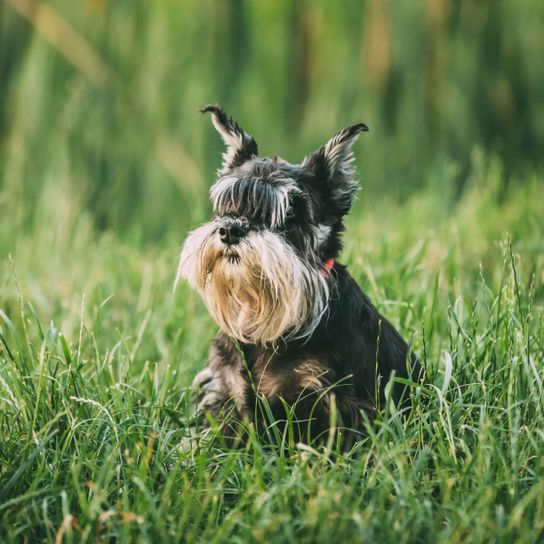

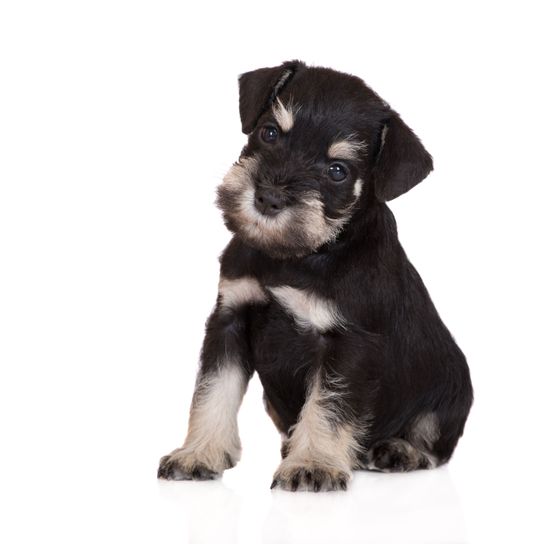
| Alternate Name | - |
| Origin | Germany |
| Life expectancy | 12 - 15 years |
| Care requirements | high-maintenance |
| Activity level | high |
| FCI group | Pinscher and Schnauzer type |
| AKC group | Terrier Group |
| KC group | Terrier Group |
Miniature Schnauzer mixes
Attitude, character and temperament of the breed
Breed description and nature
Miniature Schnauzers are very spirited, intelligent dogs that are very courageous and brave and show their loyalty to their owner. With a little guidance they are pleasant, obedient companion dogs and well suited for inexperienced dog owners. These dogs integrate well into families and are considered child-friendly. They are also suitable for keeping them in smaller city apartments. Due to their innate natural sense of alertness they sometimes tend to bark loudly as soon as someone approaches the door or rings the bell.
Characteristic for the breed is their extremely high need for exercise and stimulation.
If the great urge to move of these
- active,
- lively dogs is not sufficiently taken into account, out of boredom, they might develop
- an annoying yapper or look for stimulation by themselves, which does not always cause their owners joy.
With daily walks, ball and search games, running, swimming and other activities this can be avoided to a certain extent. The Miniature Schnauzer needs a consistent and at the same time loving upbringing, which should be continued throughout the dog's whole life. They do not forgive inconsistency. These docile dogs need clear rules. They punish any inconsistency in the use of the house rules immediately and as a result might react in a stubborn way and unpredictably. Socialising them early on is absolutely advisable. This way, this small bundle of energy also accepts other animals without any problems. Otherwise, they tend to show off and like to boast in front of other dogs.
Character
Usage
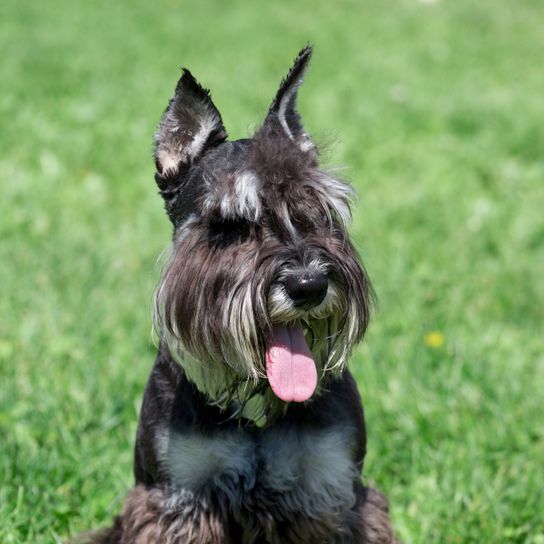

Health and breeding information
Diseases typical for this breed
Miniature Schnauzers are robust, resilient dogs by nature and are not specifically prone to any disease. However, there are some breed-specific clinical abnormalities that you should know about. Especially common is the so-called Sicca-Syndrome, which is caused by a lack of production of tear fluid. This can result in inflammation and infection of the eyes. However, this condition is not life-threatening and can be treated well with medication (e.g. eye drops). Occasionally, cases of PRA (progressive retina atrophy) or PL (loose kneecap) may also occur. These diseases require veterinary treatment. In addition, the following diseases can be observed repeatedly in the Miniature Schnauzer:
- Pancreatitis (inflammation of the pancreas)
- elevated blood lipids
- Diabetes
- Bladder stones
With the proper care and nutrition there is no reason why a long and healthy dog life could not be provided.
Care and nutrition
The wiry, short coat of the dogs must be brushed through completely twice a week. Regular trimming at the dog groomer's is recommended. This will also remove dead hair. With a little practice and a harder brush you can also trim your dog yourself. The breed does not make any special demands regarding nutrition. These active dogs, however, require a caloric nutrition. In order not to strain the small dog's stomachs excessively, several feedings per day with smaller portions make the most sense. A good mixture of foods consists of about 70% meat, 20% vegetables and 10% carbohydrates, such as rice, for example. Every now and then a chewing bone (e.g. made of buffalo skin) can have several advantages: It keeps the dog busy and cleans its teeth at the same time.
Things to know when buying a Miniature Schnauzer
If you want to buy a Miniature Schnauzer, you should only contact a breeder who is affiliated with the Pinscher Schnauzer Club 1895. Only then you are guaranteed a Miniature Schnauzer that was bred according to the FCI standard, that the dogs have a healthy genetic pedigree and that a good socialisation has already been started in the first but crucial weeks of life. A puppy with all recommended vaccinations and preventive medical checkups costs about 1.200 Euro. An alternative and even cheaper way to find a Miniature Schnauzer are animal shelters. There, with a little luck, a Miniature Schnauzer will be waiting for a new home. For a small charge of about 200 - 300 Euro you might find your dream dog. Miniature Schnauzers are also suitable for people with dog allergies. They are considered less hypoallergenic than other dog breeds. Their short coat sheds smaller amounts of hair and produces less skin scales, which are the actual allergy triggers. However, it must be clear to all interested parties that no dog breed is 100% hypoallergenic.


The Miniature Schnauzer is a rather stocky, slender dog, yet has a strong build. It looks just like its bigger brother, only slightly smaller. The rough, dense coat of the Miniature Schnauzer is weatherproof and robust. Typical for the breed is the distinctive collar of fur around the muzzle which looks like a beard, as well as the bushy brows that slightly overshadow their eyes. The coat colours range from black to pepper-salt to black-silver and white. The ears either are made to stand up straight when they are puppies or they are tilted.
Size, weight and age of a Miniature Schnauzer
The males reach a height of 30-36 cm measured at the withers and a weight of 4-9 kg. The bitches also grow to a height of 30-36 cm and reach a weight of 5-8 kg. The life expectancy of these dogs is 12 to 15 years.
| Fur length | medium |
| Fur | rough-haired |
| Ear shape | Tilt-ear |
| Tail | lang |
| Anatomy | muscular |
| Size ♀ | 30 - 39 cm |
| Weight ♀ | 5 - 8 kg |
| Size ♂ | 30 - 39 cm |
| Weight ♂ | 5 - 9 kg |
| Suitable For | Children |
Colors


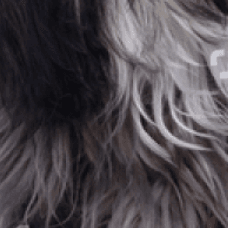




FAQ
-
A Miniature Schnauzer is considered a guard dog and is therefore very protective and alert. He often barks. With a lot of training, however, he does not mutate into a barker.
-
A Miniature Schnauzer costs from 1800 Euro. But depending on the size of the parents (small or Toy Schnauzers cost significantly more), and coloring can also cost double.
-
Yes, Miniature Schnauzers have a hunting instinct. Their original breeding intention was to guard the house and yard from rats and mice and to fight them.
-
12-15 years can become a miniature schnauzer.
Other medium dogs
Useful Articles
You can find articles that might interest you in the dogbible blog to match your favorite breed.
Visit our magazineto stay up to date on dog trends.
To find out more, view our Privacy Policy
Find here the breed that suits you and find out what character traits it has. Here you can also learn more about the origin, size and weight of your favorite breeds.
Matching your favorite breed, you'll find articles that might interest you on the dogbible dog blog.
KONG for the dog - the allround toy
Gestation dog - everything about pregnancy in dogs
Real Nature dog food - experience review and is it really that good?


















